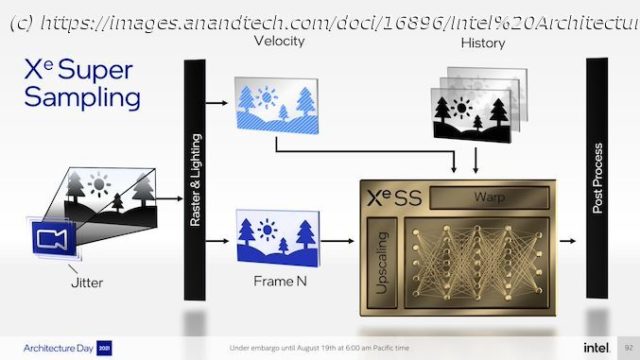Alongside a sneak peek at their forthcoming Xe-HPG architecture , the other big reveal today from Intel’s consumer graphics group comes from the software side …
Alongside a sneak peek at their forthcoming Xe-HPG architecture, the other big reveal today from Intel’s consumer graphics group comes from the software side of the business. Along with preparing Intel’s software stack for the 2022 launch of the first Arc products, the group has also been hard at work at their own take on modern, neural net-driven image upscaling techniques. The product of that research is Xe Super Sampling, or XeSS, which Intel is pitching as the best solution yet for high image quality and low processing cost image upscaling. As briefly hinted at by Intel at the start of this week with the announcement of their Arc video card brand, the company has been developing their own take on image upscaling. As it turns out, they’re actually quite far along, so for today they’re not just announcing XeSS, but they are showing off footage of the technology as well. Even better, the initial version of the SDK will be shipping to game developers later this month. XeSS (pronounced “ex-ee-ess-ess”) is, at a high level, a combination spatial and temporal AI image upscaling technique, which uses trained neural networks to integrate both image and motion data in order to produce a superior, higher resolution image. This is a field of research that has seen a great deal of research in the last half-decade, and was brought to the forefront of the consumer space a couple of years ago by NVIDIA with their DLSS technology. Intel’s XeSS technology, in turn, is designed to address similar use cases, and from a technical perspective ends up looking a lot like NVIDIA’s current DLSS 2.x technology. As with NVIDIA and AMD, Intel is looking to have their cake and eat it too with respect to graphics rendering performance.4K monitors are increasingly cheap and plentiful, but the kind of performance needed to natively render at 4K in modern AAA games is outside the reach of all but the most expensive discrete video cards. Ultimately looking to find ways to drive these 4K monitors with more modest video cards and without the traditional drop in image quality, this has led recent research into smart image upscaling techniques, and ultimately DLSS, FSR, and now XeSS. In choosing their approach, Intel seems to have gone in a similar direction as NVIDIA’s second attempt at DLSS. Which is to say, they’re using a combination of spatial data (neighboring pixels) and temporal data (motion vectors from previous frames) to feed a (seemingly generic) neural network that has been pre-trained to upscale frames from video games. Like many other aspects of today’s GPU-related announcements, Intel isn’t going into too much detail here. So there are plenty of outstanding questions about how XeSS handles ghosting, aliasing, and other artifacts that can arise from these upscaling solutions. With that said, what Intel is promising isn’t something that’s out of their reach if they’ve really done their homework. Meanwhile, given the use of a neural network to handle parts of the upscaling process, it should come as no surprise that XeSS is designed to leverage Intel’s new XMX matrix math units, which are making their debut in the Xe-HPG graphics architecture. As we saw in our sneak peek there, Intel is baking quite a bit of matrix math performance into their hardware, and the company is no doubt interested in putting it to good use.
Home
United States
USA — IT Intel Architecture Day 2021: Intel Unveils XeSS Image Upscaling Technology






